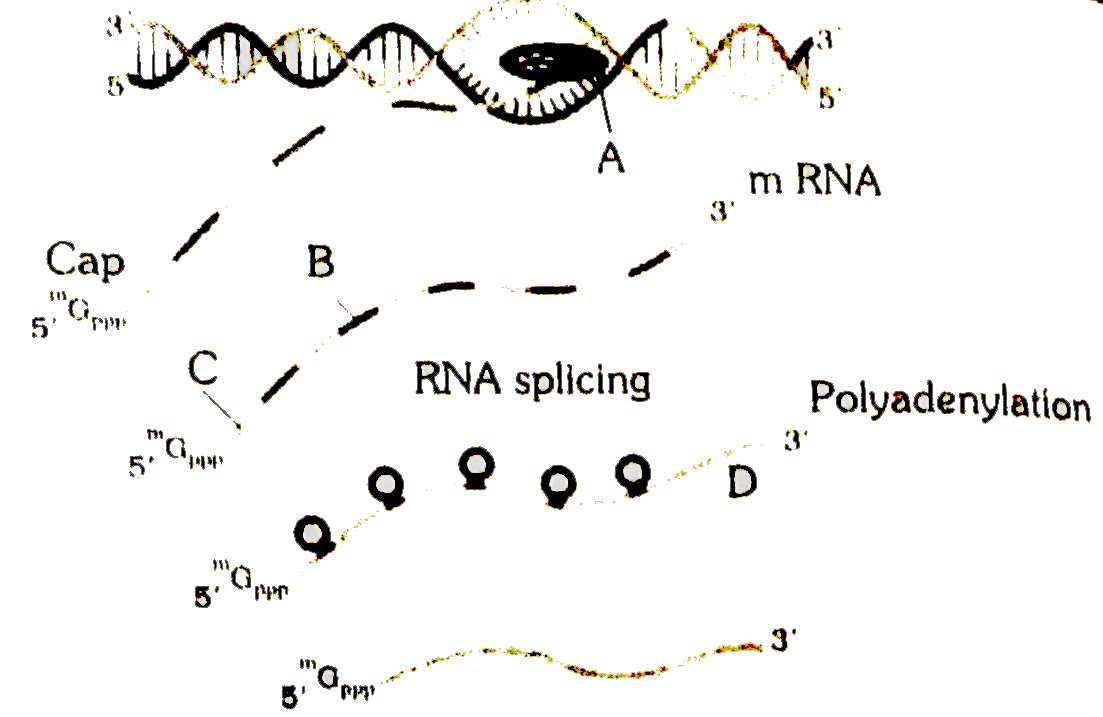(a) Give reason for -
(i) Both strands of DNA are not copied during transcription.
(ii) Transcription and translation in bacteria can be coupled.
(b) Differentiate between the process of transcription in prokaryotes and eukaryotes
Text Solution
(a)(i)If both strands act as a template, they would code for RNA molecule with different sequence in turn, they code for proteins. the sequence of amino acids in the proteins would be different. One segment of the DNA would be coding for two different proteins, and this would complicate the genetic information transfer machinery. Second, the two RNA molecules if produced simultaneously would be complementary to each other. Hence would form a double stranded RNA. This would prevent RNA from being translated into protein and the exercise of transcription would become a fertile one.
(ii)Transcription and translation take place in the same compartment since there is no separation of cytosol and nucleus in bacteria
(b) There is a single DNA dependent RNA polymerase that catalyses transcription of all types of RNA in bacteria, but in eukaryotes the RNA polymerase I transcribes rRNA, RNA polymerase III for transcription of RNA and RNA polymerase II transcribes precursor of MRNA The primary transcripts contain both exons and introns and it is subjected to a process called splicing. Also hnRNA undergo two additional processing called as capping and tailing
|
Topper's Solved these Questions
- GENETICS AND EVOLUTION BOOK - TRUEMAN BIOLOGYCHAPTER - GENETICS AND EVOLUTION EXERCISE - SECTION-A
34 Videos
- GENETICS AND EVOLUTION BOOK - TRUEMAN BIOLOGYCHAPTER - GENETICS AND EVOLUTION EXERCISE - SECTION-C
45 Videos
- GeneticsBOOK - TRUEMAN BIOLOGYCHAPTER - GeneticsEXERCISE - ASSERTION AND REASON
123 Videos
- HUMAN HEALTH AND DISEASEBOOK - TRUEMAN BIOLOGYCHAPTER - HUMAN HEALTH AND DISEASEEXERCISE - MULTIPLE CHOICE QUESTIONS
213 Videos
Similar Questions
Knowledge Check
Both the starand of DNA are not copied during transcription because :-
AIf both strands act as a templets, they would code of RNA with different sequenceBThe two RNA molecules,if produced simultaneously would be complementary to each other, hence would from a double stranded RNACThey would code, for RNA molecules with same sequencesDBoth 1 and 2 are correctAssertion :- Both the strands of DNA are not copied during transcription.
Reason : Both strands of DNA show antiparallel polarity.AIf both Assertion & Reason are True & the Reason is a correct explanation of the Assertion.BIf both Assertion & Reason are trur but Reason is not a correct explanation of the Assertion.CIf Assertion is True but the Reason is Flase.DIf both Assertion & Reason are false.The given figure refers to the process of transcription in Eukaryotes, A,B,C and D are respectively
 AA - RNA polymerase II, B - Intron, C- Exon, D - Poly G tailBA - RNA polymerase II, B - Intron, C- Exon, D - Poly A tailCA - DNA polymerase II, B - Intron, C- Exon, D - Poly A tailDA - RNA polymerase II, B - Exon, C- Intron, D - Poly A tail
AA - RNA polymerase II, B - Intron, C- Exon, D - Poly G tailBA - RNA polymerase II, B - Intron, C- Exon, D - Poly A tailCA - DNA polymerase II, B - Intron, C- Exon, D - Poly A tailDA - RNA polymerase II, B - Exon, C- Intron, D - Poly A tail
Transcription and translation can be coupled in bacteria because
View SolutionAssertion :- Both the strands of DNA are not copied during transcription.
Reason : Both strands of DNA show antiparallel polarity.
View SolutionExplain the process to transcription in prokaryotes .How is the process different in eukaryotes ?
View SolutionExplain the process to transcription in prokaryotes .How is the process different in eukaryotes ?
View SolutionAssertion : Nucleotide triphosphates acts as substrates during transcription.
Reason : Transcription and translation takes place at different sites in prokaryotes.
View Solution
